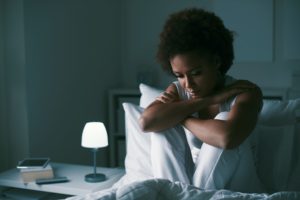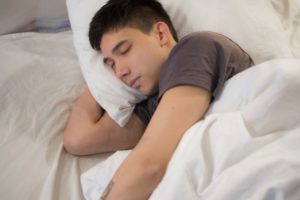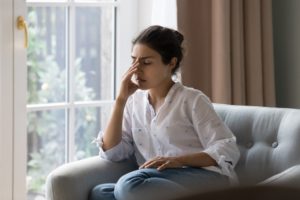Hypersomnia vs Narcolepsy
Hypersomnia and narcolepsy are disorders that make it difficult to stay awake during the day. Both conditions are characterized by a hallmark symptom called hypersomnolence. Hypersomnolence means sleeping more than the average person or feeling excessively sleepy during waking hours.
Narcolepsy and hypersomnia are considered “central disorders of hypersomnolence.” The excessive sleepiness caused by these disorders is not due to sleep disruption during the night. But narcolepsy has several characteristics that make it distinct from other, similar conditions, including hypersomnia.
What Is Narcolepsy?
Narcolepsy is a sleep disorder that causes a person to feel overly sleepy or to fall asleep at unwanted times during the day. Narcolepsy is divided into two types.
Narcolepsy Type 1
Narcolepsy type 1 is diagnosed when a person meets several criteria. First, the person must feel excessively sleepy or have an overwhelming need to sleep during the day for three or more months. This need for sleep may result in “sleep attacks,” in which a person suddenly falls asleep while engaging in an activity like walking or eating. Also, the person must experience cataplexy, have low levels of the brain chemical hypocretin-1, or both.
Cataplexy is a sudden episode of muscle weakness and loss of muscle tone, often triggered by strong positive emotions or laughter. An episode usually lasts less than two minutes. Cataplexy can make a person collapse, but unlike with fainting, the person remains conscious. Partial cataplexy may also occur, in which a person does not collapse but their facial muscles sag or their head suddenly drops forward.
Because cataplexy is frequently present in narcolepsy type 1, the disorder is sometimes referred to as narcolepsy with cataplexy. Some people with narcolepsy type 1 have cataplexy attacks several times a day, while others have them only infrequently.
Hypocretin-1, also called orexin, is a chemical made by the brain and found in the cerebrospinal fluid (CSF), which is the fluid surrounding the brain and spinal cord. Hypocretin-1 promotes wakefulness and helps to regulate sleep.
Experts have learned that a deficiency of hypocretin is what causes narcolepsy type 1. For this reason, doctors can diagnose people with narcolepsy type 1 based on low hypocretin levels in the CSF.
Many people with narcolepsy type 1 experience additional symptoms. These can include sleep paralysis, which is a brief inability to move immediately after waking. They may also have hypnagogic hallucinations, which are dreamlike hallucinations that happen as a person falls asleep. Additionally, people with narcolepsy type 1 are prone to obesity, anxiety, depression, and additional sleep disorders.
Narcolepsy Type 2
Narcolepsy type 2 is similar to narcolepsy type 1 but does not involve cataplexy or low levels of hypocretin-1. Research suggests 14% to 36% of people with narcolepsy have narcolepsy type 2. People with this type of narcolepsy experience a strong need to sleep or sudden instances of unplanned sleep daily for at least three months. These symptoms cannot be better explained by another issue, like sleep apnea.
Sometimes, a person previously diagnosed with narcolepsy type 2 develops cataplexy or learns they have low levels of hypocretin-1. In these instances, doctors often change the diagnosis from narcolepsy type 2 to narcolepsy type 1. Researchers have not yet determined what can cause someone with narcolepsy type 2 to develop narcolepsy type 1.
Causes of Narcolepsy
Narcolepsy type 1 is caused by low levels of a natural brain chemical called hypocretin, also called orexin. Experts know little about the causes of narcolepsy type 2.
Narcolepsy type 1 has been reported to appear after certain experiences, like a head injury, long-term sleep loss, strep throat, and viral infections. However, researchers have yet to confirm whether any of these factors actually increase risk for or cause narcolepsy type 1.
People with narcolepsy type 1 frequently have variations in certain genes, though not everyone with those variations develops narcolepsy. People with a close relative who has narcolepsy are 10 to 40 times more likely to develop it themselves. Still, the overall risk is relatively low. Only 1% to 2% of people who have a close family member with narcolepsy will develop it themselves.

What Is Hypersomnia?
The term “hypersomnia” broadly refers to sleep disorders that, like narcolepsy, are considered central disorders of hypersomnolence. These disorders share the common symptom of excessive sleepiness or a strong urge to fall asleep during the day.
Idiopathic Hypersomnia
To be diagnosed with idiopathic hypersomnia, a person must have excessive daytime sleepiness every day for three or more months. This sleepiness must not be due to sleep deprivation or another sleep disorder.
People with idiopathic hypersomnia must meet objective criteria and not just report feeling excessively sleepy. For example, a person must be recorded either sleeping for over 11 hours in a 24-hour period or falling asleep in less than eight minutes during a daytime test of sleepiness.
A symptom called sleep inertia commonly occurs with idiopathic hypersomnia. Sleep inertia involves having trouble waking up. A person with sleep inertia may keep falling back asleep, be unable to successfully wake up using an alarm clock, or feel confused or irritable after waking up.
Kleine-Levin Syndrome
In Kleine-Levin syndrome, periods of excessive sleepiness come and go over time. Many people with the disorder sleep from 16 to 20 hours per day during these periods. To be diagnosed, a person must have bouts of sleepiness at least once every year and a half.
The excessive sleepiness of Kleine-Levin syndrome generally lasts between two days and five weeks, with an average time of 10 days. A diagnosis is only given if no other disorder, such as a different sleep disorder or a psychiatric condition, can explain the symptoms.
During a period of excessive sleepiness, a person with Kleine-Levin syndrome can also have mental or behavior changes such as trouble thinking, an eating disorder, or a lack of inhibition. Many experience derealization, a state of mind that makes things feel unreal. When the period of sleepiness ends, these other symptoms tend to recede as well.
Hypersomnia Due to a Medical Disorder
Many medical conditions can cause excessive sleepiness or unwanted bouts of sleep during the day. If the sleepiness continues for three or more months, and is not related to a known sleep or psychiatric disorder or its treatment, a patient may be diagnosed with hypersomnia.
- Parkinson’s disease: Some people with this neurological condition experience sleep problems unrelated to insomnia or medication.
- Traumatic brain injury: Hypersomnia commonly occurs after traumatic brain injuries, perhaps because of harm to the part of the brain that produces hypocretin.
- Genetic disorders: Multiple genetic disorders are associated with increased sleepiness, including Niemann Pick type C disease, Norrie disease, Prader-Willi syndrome, and others.
- Brain tumors, infections, and other central nervous system lesions: Tumors, infections, strokes, and other illnesses that impact the brain may cause excessive sleepiness.
- Endocrine disorders: Hypothyroidism , a disorder that involves low levels of thyroid hormone, can cause excessive sleepiness, as can other hormonal disorders.
- Encephalopathy: People with hepatic encephalopathy , a category of neurological disorders caused by liver dysfunction, often experience excessive sleepiness.
- Obstructive sleep apnea: Obstructive sleep apnea is a sleep disorder that can cause daytime sleepiness. If that sleepiness continues even after successful treatment, a person may be diagnosed with hypersomnia.
Hypersomnia Due to a Medication or Substance
Taking or withdrawing from certain drugs can cause excessive sleepiness or the tendency to fall asleep at unplanned times. For the hypersomnia diagnosis to apply, there can be no other disorder that explains these symptoms in an individual. There are three subtypes of hypersomnia due to a medication or substance.
- Hypersomnia due to sedating medications: Many medications have a sedative effect and can cause drowsiness. These include some anxiety medications, sleeping pills, pain medications, antidepressants, and allergy medications.
- Hypersomnia due to substance abuse: Abusing certain drugs—including alcohol, certain anxiety and sleep medications, pain medications, and cannabis—can increase daytime sleepiness.
- Hypersomnia due to stimulant withdrawal: If a person abruptly stops taking stimulants, whether prescription medications or illegal drugs, they may subsequently feel more sleepy during the day. Even quitting caffeine can cause hypersomnia.
Hypersomnia Associated With a Psychiatric Disorder
To receive this diagnosis, a person must have both a psychiatric illness and daily excessive sleepiness for three or more months. The sleepiness must not be due to another sleep disorder, health problem, or medication.
Hypersomnia associated with a psychiatric disorder has two subtypes.
- Hypersomnia associated with a mood disorder: In this subtype, people with depression, bipolar disorder, or seasonal affective disorder find themselves spending significant amounts of time in bed.
- Hypersomnia associated with a conversion disorder or somatic symptom disorder: Conversion disorders , or somatic symptom disorders, involve physical symptoms without evidence of underlying physical disorders. In this subtype, a person’s excessive sleepiness could be due to psychological issues or unknown physical issues.
Diagnosing the Cause of Excessive Sleepiness
A person with excessive daytime sleepiness may wish to share any other symptoms and a detailed medical history with their doctor. That way, their doctor can explore other potential causes before testing for narcolepsy or hypersomnia.
Doctors often ask detailed questions or give questionnaires related to sleepiness to help guide their assessment.They may also request that a person keep a sleep diary for a specified period of time. Keeping a sleep diary involves writing down sleep and wake times, along with other information like sleep quality, for a week or two.
If doctors cannot determine the cause of daytime tiredness after gathering this information, they may order one or more sleep-related studies.
Polysomnography
Polysomnography (PSG) is the medical term for an overnight sleep study. Doctors may order this study if they suspect a person’s sleepiness stems from obstructive sleep apnea, narcolepsy, or seizures that occur during sleep.
A PSG collects multiple physical measurements while a person sleeps. These measurements allow doctors to view a sleeper’s brain wave patterns, breathing effort and rate, snoring volume, blood oxygen level, and other data.
Multiple Sleep Latency Test
The multiple sleep latency test (MSLT) is sometimes given the day after polysomnography. The MSLT measures sleepiness by monitoring how quickly a person falls asleep when given the opportunity to nap. This test can also show how quickly they enter the rapid eye movement (REM) sleep stage.
When a person falls asleep in under eight minutes during an MSLT even after sleeping enough the night before, this indicates excessive sleepiness. This measure is required to diagnose both narcolepsy and hypersomnia. If a person also enters REM sleep in less than eight minutes more than twice during an MSLT, they likely have narcolepsy, not hypersomnia.
Maintenance of Wakefulness Test
A maintenance of wakefulness test (MWT) is similar to a multiple sleep latency test but is less commonly used for daytime sleepiness. Rather than measure how quickly someone naps during the daytime, the MWT focuses on how well they can stay awake. This test may be used to help determine if someone’s sleepiness puts them at risk for accidents.
Treatments
Multiple treatments are available to help people diagnosed with central disorders of hypersomnolence, whether narcolepsy or hypersomnia.
Medication
Medications that promote wakefulness are often the first treatment prescribed to people with narcolepsy and some types of hypersomnia. The specific medication depends on a person’s unique set of symptoms and their severity. If an individual has trouble obtaining adequate sleep, they may require sleep-promoting medication at night as well.
People who have narcolepsy type 1 may also need medication to treat cataplexy. Some medications treat both cataplexy and sleepiness, while others treat only cataplexy.
Daytime Napping
Taking a nap during the day helps many people with narcolepsy feel more alert. Most still need to take medication, but some people can treat narcolepsy with strategic daytime napping alone.
Often, people with narcolepsy can increase their alertness by taking one or two short naps each day. Taking a nap in the early afternoon may stave off sleepiness for up to three hours. People with narcolepsy might make arrangements to take a brief nap during the school or work day. However, some might require a long nap to feel less sleepy.
Daytime napping is not as effective for idiopathic hypersomnia. When people with idiopathic hypersomnia take daytime naps, the naps tend to run long and not feel refreshing.
Sleep Hygiene
Since falling short on sleep can worsen narcolepsy symptoms, practicing good sleep hygiene may help. Several lifestyle changes can promote better sleep.
- Maintaining a sleep schedule: Going to sleep and waking up at the same time, even on weekends and vacations, can make sleeping easier.
- Practicing a bedtime routine: Calming activities in the evening can help a person fall asleep more easily. Avoiding bright lights and digital devices during this time is also useful, since light exposure can decrease tiredness.
- Exercising regularly: Daily exercise can help people fall asleep faster and stay asleep longer. It may also improve the quality of sleep.
- Creating a sleep-promoting environment: Keeping the bedroom cool, dark, and quiet can help someone get better sleep. Light can be avoided using blackout curtains or sleep masks, while noise can be blocked out through earplugs or white noise machines.
Avoiding Certain Drugs
Some drugs can make narcolepsy symptoms worse and are often avoided by those with the disorder. For example, some anxiety, sleep, and pain medications can increase daytime tiredness. Medications that disrupt sleep, such as stimulants, may also make people sleepy during the day. A class of blood pressure medications called alpha blockers may make cataplexy worse in those who experience it.
If you are taking a medication that you’re concerned may be making daytime sleepiness, hypersomnia, or narcolepsy worse, it’s important to speak with your doctor before making any medication adjustments.
Treating Other Disorders
Narcolepsy can be associated with many other disorders, such as depression, anxiety, high blood pressure, and obesity. Any other medical disorders should be diagnosed and treated to promote overall health.
Counseling
Doctors often counsel people with narcolepsy or hypersomnia about risks associated with their sleep disorder. For example, driving or operating machinery can be dangerous when a person could suddenly fall asleep. Doctors may advise those with this risk to coordinate their naps and medication around their driving and machine use. They may also encourage them to drive only at certain times of the day or for shorter periods.
When to Talk to Your Doctor
If you find yourself consistently feeling tired or sleeping longer than usual, consider speaking with a doctor. Your doctor can ask questions and order tests to determine the cause of your symptoms and the most appropriate treatment options for you.

Still have questions? Ask our community!
Join our Sleep Care Community — a trusted hub of sleep health professionals, product specialists, and people just like you. Whether you need expert sleep advice for your insomnia or you’re searching for the perfect mattress, we’ve got you covered. Get personalized guidance from the experts who know sleep best.
References
9 Sources
-
Scammell, T. E. (2020, August 11). Clinical features and diagnosis of narcolepsy in adults. In A. F. Eichler (Ed.). UpToDate., Retrieved May 25, 2022, from
https://www.uptodate.com/contents/clinical-features-and-diagnosis-of-narcolepsy-in-adults -
Surks, M. I. (2020, October 12). Clinical manifestations of hypothyroidism. In D. S. Ross (Ed.). UpToDate., Retrieved June 1, 2022, from
https://www.uptodate.com/contents/clinical-manifestations-of-hypothyroidism -
Ferenci, P. (2022, April 27). Hepatic encephalopathy in adults: Clinical manifestations and diagnosis. In B. A. Runyon (Ed.). UpToDate., Retrieved June 1, 2022, from
https://www.uptodate.com/contents/hepatic-encephalopathy-in-adults-clinical-manifestations-and-diagnosis -
Stone, J. (2022, April 12). Conversion disorder in adults: Terminology, diagnosis, and differential diagnosis. In J. Dimsdale (Ed.). UpToDate., Retrieved June 1, 2022, from
https://www.uptodate.com/contents/conversion-disorder-in-adults-terminology-diagnosis-and-differential-diagnosis -
Chervin, R. D. (2022, January 31). Idiopathic hypersomnia. In T. E. Scammell (Ed.). UpToDate., Retrieved June 3, 2022, from
https://www.uptodate.com/contents/idiopathic-hypersomnia -
Chervin, R. D. (2021, September 29). Approach to the patient with excessive daytime sleepiness. In T. E. Scammell (Ed.). UpToDate., Retrieved June 2, 2022, from
https://www.uptodate.com/contents/approach-to-the-patient-with-excessive-daytime-sleepiness -
Kramer, N. R. & Millman, R. P. (2021, November 5). Overview of polysomnography in adults. In S. M. Harding (Ed.). UpToDate., Retrieved June 2, 2022, from
https://www.uptodate.com/contents/overview-of-polysomnography-in-adults -
Scammell, T. E. (2022, January 30). Treatment of narcolepsy in adults. In R. Benca (Ed.). UpToDate., Retrieved June 3, 2022, from
https://www.uptodate.com/contents/treatment-of-narcolepsy-in-adults -
Maski, K. (2021, February 19). Insufficient sleep: Evaluation and management. In T. E. Scammell (Ed.). UpToDate., Retrieved June 3, 2022, from
https://www.uptodate.com/contents/insufficient-sleep-evaluation-and-management





